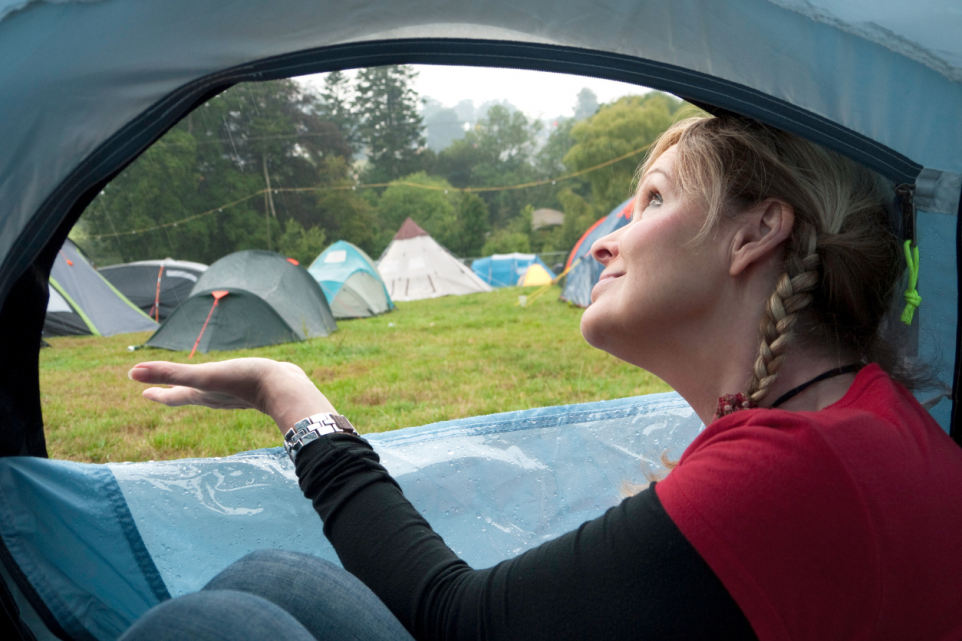7 Tips for Safely Camping in the Rain

Camping has an innate charm that draws adventurers to the great outdoors, promising serene nights under the stars and days filled with exploration. However, nature has a way of throwing surprises our way, and one of the most unpredictable is rain. While it might seem like a wet blanket on your camping plans, with the right knowledge and preparation, camping in the rain can be an exhilarating and memorable experience.
In this guide, we’ll share seven invaluable tips to help you navigate the challenges of wet-weather camping. From selecting the perfect campsite to staying dry with top-notch gear and creating cozy rain-free zones, we’ve got you covered. Discover how to keep your spirits high, and your gear dry while embracing the beauty of nature’s tears. So, if you’ve ever contemplated a camping trip in less-than-ideal weather, read on to learn how to turn those rainy days into a unique and unforgettable outdoor adventure.
Choose the Right Location
When planning a camping trip during the rainy season or in an area known for unpredictable weather, it’s essential to pick the right location. Look for less-prone-to-flooding campsites, ideally elevated or well-drained spots. Avoid setting up your campsite near riverbanks or low-lying areas where water can accumulate quickly. State and national park websites often provide information about campsite drainage and suitability for wet-weather camping.
Invest in Quality Rain Gear
Invest in high-quality rain gear to stay dry while camping in the rain. A waterproof jacket, pants, and hiking boots are essential for your outdoor wardrobe. Carry an EDC flashlight (everyday carry) for setting up camp and navigating in dim, rainy conditions. Use a waterproof tarp or groundsheet beneath your tent to safeguard its interior, and add an extra layer of protection with a rainfly. Create a dry haven by setting up a portable pop-up canopy or tarp, securing everything with extra rope and guy lines to prevent wind issues. Finally, use waterproof storage containers or dry bags to protect sensitive gear from moisture.
Set Up a Rainfly
If your tent doesn’t have a built-in rainfly, bring one or purchase a separate rainfly that fits your tent’s size and shape. A rainfly is a waterproof cover that covers your tent to keep rainwater from seeping through the fabric. It’s a simple but effective way to prevent water from entering your shelter during a downpour.
Create a Rain-Free Zone
When camping in the rain, having a designated rain-free zone is essential where you can cook, eat, and relax without getting wet. This can be a tarp suspended between trees, a portable canopy, or even the vestibule of your tent if it’s spacious enough. Having a dry area to retreat to can make your camping experience much more enjoyable, especially when the weather takes a turn for the worse.
Pack Appropriate Clothing
In addition to your rain gear, pack plenty of moisture-wicking clothing layers. Opt for synthetic or wool fabrics that wick moisture away from your body, keeping you warm and dry even if you get wet. It’s a good idea to bring extra sets of clothes to change into dry ones if needed. Don’t forget waterproof gloves and a hat to keep your hands and head dry.
Stay Hygienic
Camping in the rain can present challenges when staying clean and dry. To maintain hygiene and comfort, consider bringing biodegradable wet wipes, a portable camp shower, or a small basin for washing dishes and yourself. Proper hygiene can help prevent discomfort and illness during wet weather camping trips.
Practice Leave No Trace
Camping responsibly and respecting the environment is crucial, especially in wet conditions when ecosystems can be more sensitive to disturbance. Follow Leave No Trace principles by minimizing your impact on the environment. Use established campsites, pack out all trash, and avoid trampling on delicate vegetation. In rainy weather, your environmental impact can be more significant, so it’s essential to be extra mindful of your surroundings.
Your Adventure, Our Experience
At TheCampingList, our dedication to authenticity and reliability stems from our own adventures in the great outdoors. Our team, comprised of seasoned experts in hiking, camping, climbing, cycling, fishing, and hunting, rigorously tests every product and shares insights drawn from real experiences. This hands-on approach ensures our reviews and guides meet the highest standards of durability, functionality, and comfort. Moreover, our platform thrives on the rich contributions and feedback from our vibrant community of enthusiasts. We pride ourselves on delivering unbiased, educational content that empowers and informs your outdoor pursuits. Trust in TheCampingList for genuine advice and support, where we're all about enriching your journey, every step of the way.